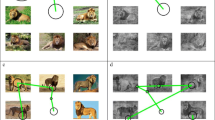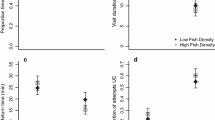Summary
Cooperative behavior during predatorinspection visits of the guppy (Poecilia reticulata) was examined. Wild caught guppies from Trinidad were tested on two types of mirror. In one treatment individual guppies were tested using a long mirror that ran parallel to the path toward the predator. In the second treatment, guppies were tested with a shorter mirror that was placed at an angle of thirty-two degrees to the path toward the predator. Guppies in both mirror treatments showed consistent behavior throughout a trial, with subjects in the straight-mirror treatment spending more time near the predator. It appears that guppies employ a “conditional-approach” strategy during predator inspections. The conditional-approach strategy instructs a player to swim toward the predator (inspect) on the first move of a game and subsequently only to move forward if the other player swims beside it. “Conditional-approach” is analogous to a TIT FOR TAT strategy, the difference being that the conditional-approach strategy makes no assumptions about the player's payoff matrix.
Similar content being viewed by others
References
Axelrod R (1980a) Effective choice in the Prisoner's Dilemma. J Conflict Resolution 24:3–25
Axelrod R (1980b) More effective choices in the Prisoner's Dilemma. J Conflict Resolution 24:379–403
Axelrod R (1984) The evolution of cooperation. Basic Books
Axelrod R, Hamilton W (1981) The evolution of cooperation. Science 211:1390–1396
Boyd R, Lorberbaum J (1987) No pure strategy is evolutionarily stable in the repeated Prisoner's Dilemma game. Nature 327:58–59
Dominey W (1983) Mobbing in colonially nesting fishes, especially the blue-gill, Lepomis machrochirus. Copeia 4:1086–1088
Endler JA (1986) Defense against predators. In: Feder M, Lauder L (eds) Predator-prey relationships: Perspectives and approaches from the study of lower vertebrates. The University of Chicago Press, Chicago
Falger V (1986) The evolution of cooperation. J Soc Bio Structure 9:204–206
Fraser D, Gilliam J (1987) Feeding under predation hazard: response of the guppy and Hart's rivulus from sites with contrasting predation hazard. Behav Ecol Sociobiol 21:203–209
George C (1960) Behavioral interaction in the pickerel and the mosquitofish. PhD Thesis, Harvard University
Hirschleifer J, Martinez-Coll JC (1987) What strategies can support the evolutionary emergence of cooperation. Center for International and Strategic Affairs. Working Paper No. 58, UCLA
Liley N, Seghers B (1975) Factors affecting the morphology and behavior of the guppy Poecilia reticulata in Trinidad. In: Baerands GP, Beer C, Manning A (eds) Functions and evolution in behavior. Oxford University Press, Oxford, pp 92–118
Lombardo M (1985) Mutual restraint in tree swallows: A test of the TIT FOR TAT model of reciprocity. Science 277:1363–1365
Maynard Smith J (1982) Evolution and the theory of games. Cambridge University Press, Cambridge
Maynard Smith J, Price GR (1973) The logic of animal conflict. Nature 246:15–18
Magurran AE, Girling S (1986) Predator recognition and response habituation in shoaling minnows. Anim Behav 34:510–518
Magurran AE, Pitcher TJ (1987) Provenance, shoal size and the sociobiology of predator evasion in minnow shoals. R Soc of London Proc Series B 229:439–465
Milinski M (1987) TIT FOR TAT and the evolution of cooperation in sticklebacks. Nature 325:433–435
Motta P (1983) Response by potential to prey to coral reef predators. Anim Behav 31:1257–1259
Pitcher TJ, Green D, Magurran AE (1986) Dicing with death: predator inspection behavior. J Fish Bio 28:1439–1448
Rapoport A, Chummah A (1965) Prisoner's Dilemma: A study in conflict and cooperation. The University of Michigan Press, Michigan
Rapoport A (1974) Prisoner's Dilemma-recollections and observations. In: Rapoport A (ed) Game theory as a theory of conflict resolution. Dordrecht Reidel, pp 18–34
Schelling T (1960) The strategy of conflict. Harvard University Press, Harvard
Seghers B (1973) An analysis of geographic variation in the anti-predator adaptations of the guppy Poecilia reticulata. PhD Thesis, University of British Columbia
Trivers R (1971) The evolution of reciprocal altruism. Q Rev Biol 46:35–57
Wilkinson GS (1984) Reciprocal food sharing in the vampire bat. Nature 308:181–184
Author information
Authors and Affiliations
Rights and permissions
About this article
Cite this article
Dugatkin, L.A. Do guppies play TIT FOR TAT during predator inspection visits?. Behav Ecol Sociobiol 23, 395–399 (1988). https://doi.org/10.1007/BF00303714
Received:
Accepted:
Issue Date:
DOI: https://doi.org/10.1007/BF00303714




